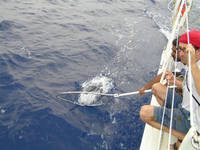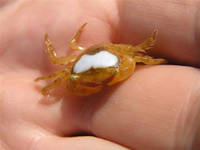May 5, 2005
The Sargasso by the prow side!
The Sargasso sea…. It is so different from any other place on earth that it may well be considered a definite geographic region “. By Rachel Carson.

“Land on sight!” after months of navigation, Christopher Columbus’s caravels began to encounter large clusters of yellow brownish algae, on which small crabs and crustaceans of all types floated. The Great Admiral thought that, at last, they had reached land. His calculation was erroneous. They were in the Sargasso Sea, at more than 1.000 miles from the American continent. The Portuguese named it that way because of the immense accumulation of algae floating adrift for kilometers after kilometers, it reminded them of a common grape from their country, the “salgazo”.
The Sargasso Sea occupies 2.000 square meters, extending almost from the US coast, to the proximity of Azores, and it is estimated that it may contain around six million tons of these algae. These include two predominant species: Sargassum natans and Sargassum fluitans. Unlike other similar algae from the Mediterranean or the European Atlantic Sea, these two types of Sargasso are not attached to the substrate, but live exclusively adrift. In order to float, they use small capsules filled with oxygen, nitrogen and carbon dioxide. The Ranger is now traveling through the south side, where algae density is lower.

Throughout the Oceana crossing towards Bermuda, in addition to our sightings of fascinating Portuguese man-of-war (Physalia physalis), we have also seen clusters of Sargasso, but for now they are a bit small in size and expansion. We gathered some samplings using a net similar to those used to catch butterflies, but bigger. Upon examining them in detail, Ricardo and Indi discovered a colony of crabs, sheltered between the algae, the biggest of them was no larger than 3 centimeters…a little prawn measuring half a centimeter also shows up, squirming desperate to go back in the water.
Because of the large concentration of life forms and nutrients found in the Sargasso, great numbers of turtles abound in this place. They arrive just after they are born in the nesting beaches of Central America, Florida and Bahamas, to spend what is known as “the lost year” of turtles, before they begin their long migration. They take advantage of the Gulf current to reach the Sargasso Sea and from here, they continue to the European Atlantic and Mediterranean seas. Some 400.000 of them will be captured accidentally by the swordfish fisheries in the Mediterranean.

“Sargasso Sea on sight!” We are very close, but again, because of dire weather predictions, the Ranger must change its plans once more. At 4:20 pm on Thursday May 5, the captain instructs the first officer to change course. Crew members reset the direction of the mizzen sail and the jib is deployed. We temporarily postpone our crossing towards the heart of the Sargasso Sea. Now we set sails for Bermuda. According to Nuño’s calculations, we should arrive there on Friday after midday. The transoceanic expedition will take refuge there from the storm that is approaching and that will reach its maximum magnitude in the next few days.

